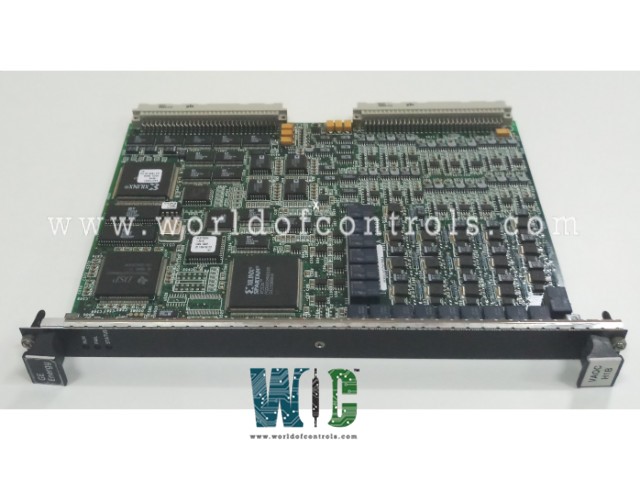
World Of Controls understands the criticality of your requirement and works towards reducing the lead time as much as possible.
IS200VAOCH1BBA - VME Analog Output Terminal Board is available in stock which ships the same day.
IS200VAOCH1BBA - VME Analog Output Terminal Board comes in UNUSED as well as REBUILT condition.
To avail our best deals for IS200VAOCH1BBA - VME Analog Output Terminal Board, contact us and we will get back to you within 24 hours.
SPECIFICATIONS:
Part Number: IS200VAOCH1BBA
Manufacturer: General Electric
Series: Mark VI
Product Type: Analog Output Board
Bus Type: VMEbus
Number of channels: 16
Output Voltage Range: ±10V, 0-10V, 0-5V
Output Resolution: 12-bit
Output Impedance: 10 Ω
Analog outputs: 0-20 mA
Output Drive Capability: ±10mA
Operating Temperature: -40°C to +85°C
Frame Rate: 100 Hz
Repair: 3-7 Day
Availability: In Stock
Country of Origin: United States
Manual: GEH-6421L
FUNCTIONAL DESCRIPTION:
IS200VAOCH1BBA is a VME Analog Output Terminal Board manufactured and designed by General Electric as part of the Mark VI Series used in the GE Speedtronic Gas Turbine Control Systems. The Analog Output Board (VAOC) controls 16 analog, 20 mA, outputs. These outputs are wired to two terminal blocks on the Analog Output Terminal Board (TBAO). Cables with molded plugs connect the terminal board to the VME rack where the VAOC processor board is located. The VAOC receives digital values from the controller over the VME backplane from the VCMI, converts these to analog output currents, and sends them to the TBAO. The actual output current is measured on the terminal board and fed back to VAOC where it is controlled. In TMR applications, control signals are fanned into the same terminal board from three VME board racks R, S, and T as shown in the following figure. Six cables are required to support all 16 outputs with TMR. Each final current output is the median select of the three currents in the three VAOCs, and this median select circuit is in each VAOC.
COMPATIBILITY:
The VAOC board and accompanying terminal boards come in two generations. All VAOC iterations up to and including VAOCH1B are considered to be the original VAOC. These boards can handle up to a 500-load resistance at the end of 1000 ft (304.8 m) of #18 wire when driving 20 mA outputs. For optimal operation, this generation needs a terminal board TBAOH1B or earlier, or any DTAI revision.
Higher load resistance on the first eight output circuits is supported by the most recent VAOC board, VAOCH1C, as well as any ensuing releases. At the screw terminals on the terminal board, a drive voltage of up to 18 V is available for 20 mA outputs. This enables the use of 1000 ft (304.8 m) of #18 wire with a margin of 800 load resistance. The original VAOC's 500 rating is carried over to the second set of eight output circuits. TBAOH1C or later is required for VAOCH1C.
INSTALLATION:
OPERATION:
VAOC supports 16 analog 0-20 mA outputs. The VAOC contains the D/A converter and driver that generates the controlled currents, as shown in the following figure. The output current is measured by the voltage drop across a resistor on the terminal board. There are two generations of the VAOC board with corresponding terminal boards. The original VAOC includes all versions before and including VAOCH1B. When driving 20 mA outputs these boards support up to 500 W load resistance at the end of 1000 ft of #18 wire. This generation of the board requires terminal board TBAOH1B or earlier for proper operation. They also work properly with all revisions of DTAI terminal boards.
WOC has the largest stock of OEM Replacement Parts for GE Speedtronic Turbine Control Systems. We can also repair your faulty boards and supply unused and rebuilt boards backed up with a warranty. Our team of experts is available round the clock to support your OEM needs. Our team of experts at WOC is happy to assist you with any of your automation requirements. For pricing and availability on parts and repairs, kindly contact our team by phone or email.
What is a VME Analog Output Terminal Board?
A VME Analog Output Terminal Board is a critical component used in VME (Versa Module Eurocard) systems, providing analog output signals to various devices and applications. It interfaces directly with the VME bus and allows systems to generate analog signals necessary for processes in industrial automation, instrumentation, and control systems.
What are the main features of a VME Analog Output Terminal Board?
The primary features of a VME Analog Output Terminal Board typically include multiple output channels that enable the simultaneous generation of various analog signals. These boards offer high-resolution output, ensuring that the analog signals generated are accurate and reliable for the system.
What is the voltage range supported by the VME Analog Output Terminal Board?
The voltage range supported by a VME Analog Output Terminal Board can vary depending on the specific model. However, most boards are designed to output standard voltage ranges such as 0-10V, ±10V, or current loops like 4-20mA, which are commonly used in industrial automation and control systems.